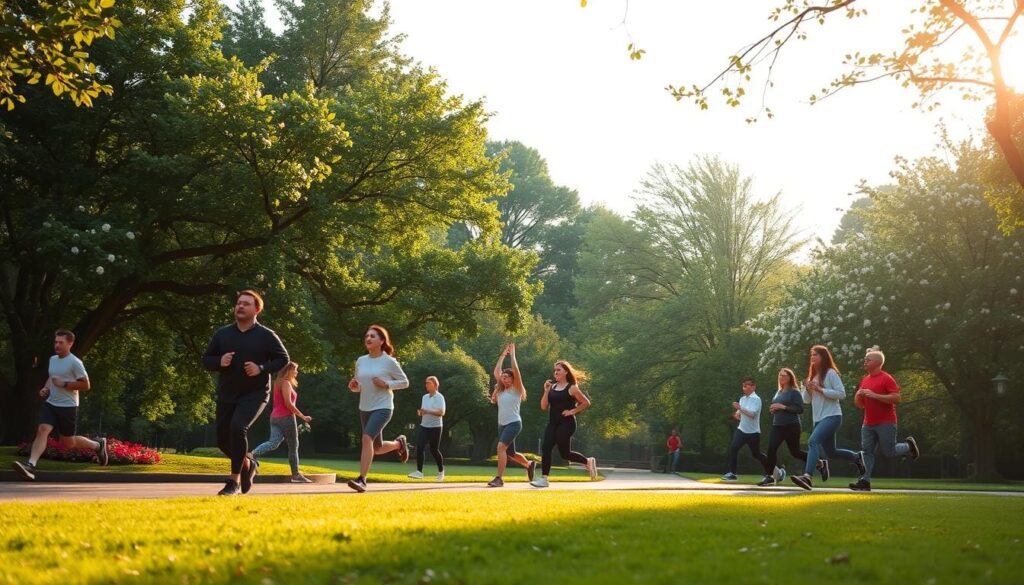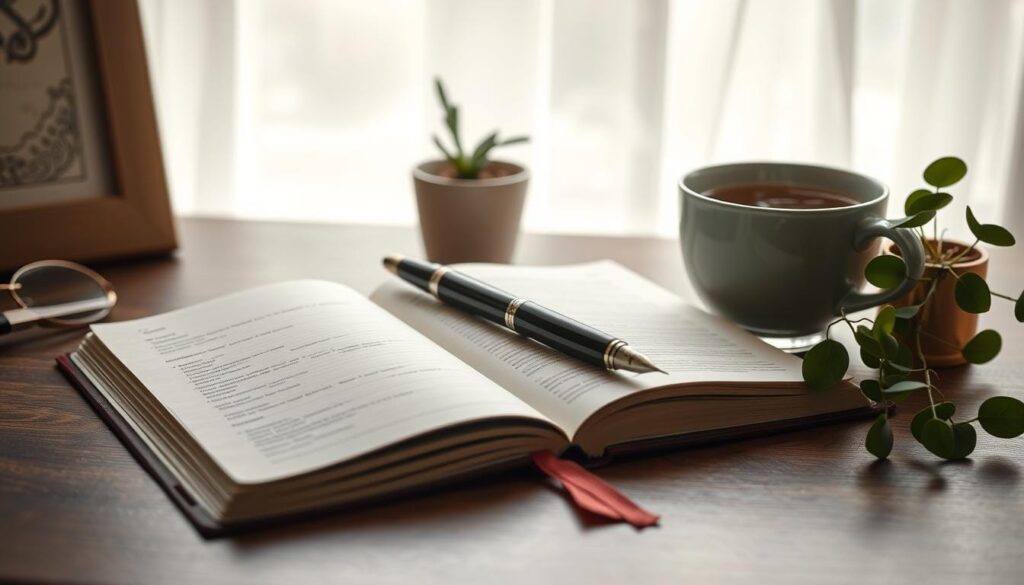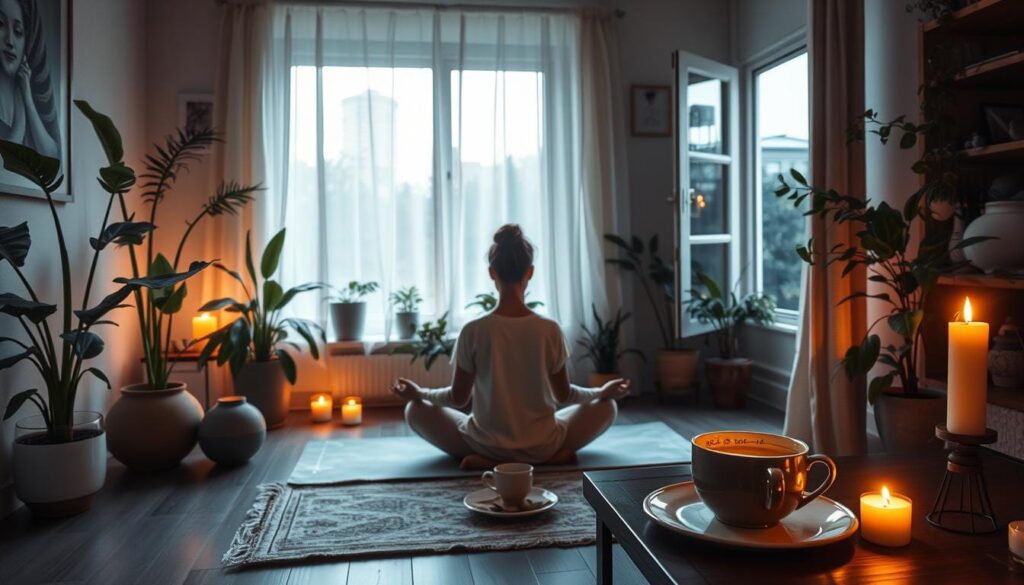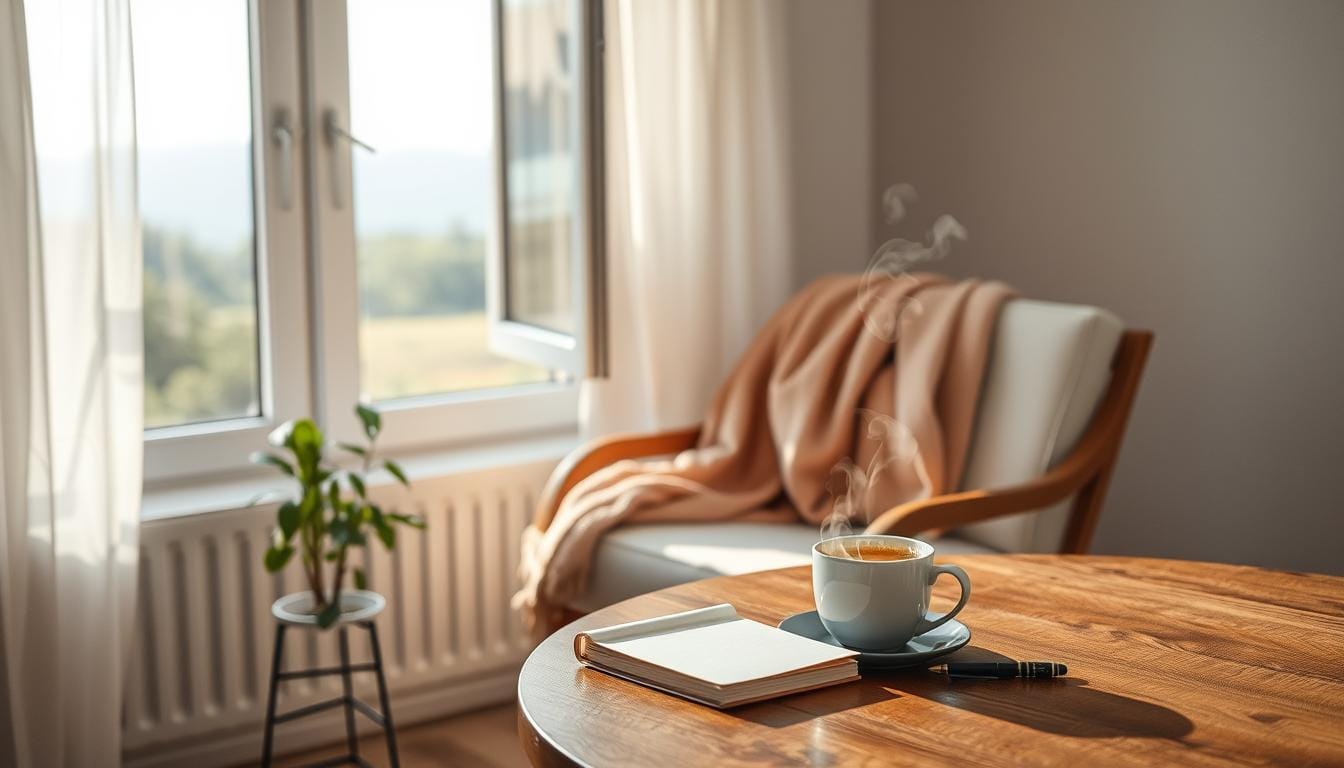Anxiety, the persistent feeling of unease and worry, has become a common companion in our fast-paced modern lives. As we navigate the daily demands of work, family, and personal responsibilities, it’s easy to feel overwhelmed, leading to a constant state of stress and tension. However, what if I told you that there are simple, natural remedies and lifestyle changes that can help you manage daily anxiety and find the relief you deserve?
In this article, we’ll explore a range of strategies and techniques that have been proven effective in reducing anxiety symptoms and promoting overall well-being. From mindfulness practices and physical activity to dietary changes and creating a comfortable living environment, we’ll provide you with the tools to take control of your anxiety and reclaim your peace of mind.
Key Takeaways
- Understand the impact of daily anxiety and its common symptoms.
- Establish a structured routine and make time for self-care activities.
- Explore mindfulness techniques to reduce stress and anxious thoughts.
- Incorporate physical activity and healthy nutrition into your lifestyle.
- Utilize breathing exercises and relaxation practices for instant relief.
Understanding Daily Anxiety and Its Impact
Anxiety is a natural human response to stress and perceived threats, but when it becomes persistent and interferes with our daily lives, it can significantly impact our emotional well-being. Daily anxiety, a common experience, is characterized by a constant state of worry or fear about everyday situations. This type of anxiety can manifest in both physical and mental symptoms, making it crucial to understand its nature and underlying causes.
What Is Daily Anxiety?
Daily anxiety refers to the persistent and excessive worries or fears that individuals experience about routine tasks, interactions, or situations. It is a form of generalized anxiety disorder (GAD) where the anxiety is not tied to a specific event or trigger but rather a general sense of unease or apprehension. This type of anxiety can make it challenging to focus, relax, and enjoy daily activities.
Symptoms of Daily Anxiety
- Increased heart rate and rapid breathing
- Sweating and trembling
- Muscle tension and restlessness
- Difficulty concentrating and making decisions
- Irritability and feelings of apprehension
- Gastrointestinal issues, such as nausea or diarrhea
Causes of Daily Anxiety
The causes of daily anxiety can vary, but they often stem from a combination of factors, including:
- Stress related to work, finances, or personal relationships
- Underlying health concerns or chronic medical conditions
- Traumatic experiences or past traumas
- Genetic predisposition or chemical imbalances in the brain
- Environmental factors, such as exposure to toxins or pollution
Understanding the root causes of daily anxiety is crucial for developing effective coping strategies and finding relief from this common yet debilitating condition. By addressing the underlying factors, individuals can take steps to manage their anxiety and improve their overall emotional well-being.
“Anxiety disorders are the most common mental health condition in the U.S., affecting approximately 40 million adults annually.”
Establishing a Daily Routine
Maintaining a structured daily routine can be a powerful tool in managing daily anxiety and promoting overall well-being. When we establish a consistent schedule, it provides a sense of control and predictability, which can significantly reduce stress levels. By incorporating self-care activities into our daily routine, we can effectively address the underlying causes of anxiety and find relief.
Importance of Structure
Research has shown that setting a consistent sleep schedule can improve the quality of our rest, enhancing both our psychological well-being and productivity. Additionally, establishing routines for activities like meal planning and exercise can contribute to a healthier lifestyle, ultimately reducing the impact of anxiety.
Families with established routines have also been found to exhibit improvements in children’s social skills and academic performance, while children exposed to such routines are less likely to develop behavior disorders like oppositional defiant disorder. Even individuals in addiction recovery and those with bipolar disorder can benefit from structured routines, which can help replace harmful behaviors and manage their conditions more effectively.
Making Time for Self-Care
Incorporating self-care activities into our daily routine is crucial for managing stress and anxiety. Whether it’s engaging in a mindfulness practice, indulging in a hobby, or simply setting aside time for relaxation, these self-care rituals can have a significant impact on our overall well-being.
It’s important to remember that establishing a new habit takes time, with research suggesting that it can take an average of 66 days to form a lasting routine. By using tools like fitness trackers, we can aid in the process of forming and maintaining these healthy habits. Additionally, allowing for some flexibility in our routine adherence is encouraged, as occasional breaks do not necessarily derail our progress and may even help in long-term compliance.
By prioritizing structure and self-care in our daily lives, we can take meaningful steps towards managing daily anxiety and finding relief from the stresses of everyday life.
Mindfulness Practices to Reduce Anxiety
Incorporating mindfulness techniques, including meditation, can be a powerful way to manage daily anxiety and find relief. Mindfulness practices enhance our awareness of the present moment, promoting a sense of calm and reducing the physiological effects of stress.
Benefits of Mindfulness
Research has shown that mindfulness meditation can be just as effective as prescription medication in treating anxiety disorders. Regular practice can also lead to positive changes in brain structure, improving attention, memory, and emotional regulation. Mindfulness has been linked to improved immune function, reduced inflammation, and activation of the parasympathetic nervous system, which helps the body relax.
Simple Mindfulness Techniques to Try
- Focused Breathing: Take a few minutes to focus on your breath, observing the inhalation and exhalation without judgment.
- Body Scan: Mentally scan your body from head to toe, noticing any areas of tension or discomfort without trying to change them.
- Sensory Awareness: Engage your senses by focusing on the sights, sounds, smells, or textures in your immediate environment.
- Mindful Walking: As you walk, pay attention to the sensation of your feet touching the ground and the movement of your body.
Incorporating these simple mindfulness techniques into your daily routine can help reduce anxiety and promote a greater sense of mental well-being. Remember, the key is to be patient and consistent with your practice, as the benefits of meditation can take time to fully manifest.
“Mindfulness is a way of befriending ourselves and our experience.” – Jon Kabat-Zinn
Physical Activity and Its Role in Easing Anxiety
Regular physical activity has been shown to be a highly effective way to manage and reduce daily anxiety. Exercise releases endorphins, improves mood, and enhances sleep quality – all of which can contribute to lowering anxiety levels. From brisk walking to swimming and yoga, there are various types of exercises we can incorporate into our routines to experience the anxiety-reducing benefits of physical activity.
How Exercise Affects Anxiety Levels
Numerous studies have demonstrated the positive impact of exercise on anxiety symptoms. A recent systematic review and meta-analysis of 11 randomized controlled trials involving 770 geriatric participants revealed a significant overall effect of physical activity in reducing anxiety. The analysis showed a standardized mean difference (SMD) of -0.60, with a 95% confidence interval (CI) of -0.88 to -0.32, indicating that exercise can effectively alleviate anxiety symptoms compared to control groups.
Types of Exercises We Can Incorporate
- Brisk walking: A simple and accessible activity that can be easily integrated into our daily lives.
- Swimming: A low-impact exercise that can promote relaxation and improve mood.
- Yoga: A mind-body practice that combines physical postures, breathing exercises, and meditation to calm the mind and body.
- Strength training: Engaging in resistance exercises can help manage stress and boost self-confidence.
- Cycling: An enjoyable outdoor activity that can reduce anxiety while improving cardiovascular health.
Experts recommend aiming for at least 30 minutes of moderate exercise most days of the week to experience the full anxiety-reducing benefits of physical activity. By incorporating a variety of exercises into our daily routines, we can take a proactive step towards managing our anxiety and improving our overall well-being.

“Regular physical activity can be a powerful tool in managing daily anxiety. By engaging in a variety of exercises, we can not only reduce our anxiety symptoms but also improve our physical and mental health overall.”
Nutrition and Anxiety: What We Eat Matters
When it comes to managing daily anxiety, our diet plays a crucial role. Numerous studies have explored the connection between nutrition and anxiety, unveiling the powerful impact that what we consume can have on our mental well-being.
Foods That Help Reduce Anxiety
Incorporating certain anxiety-reducing foods into our diet can be a valuable strategy. Research has shown that foods rich in omega-3 fatty acids, such as fatty fish like salmon, can help alleviate anxiety symptoms. Complex carbohydrates, like whole grains, can also have a calming effect by supporting stable blood sugar levels. Additionally, antioxidant-rich foods, such as berries and leafy greens, have been linked to reduced anxiety.
The Impact of Caffeine and Sugar
While some people may turn to caffeine and sugar for a quick energy boost, these substances can actually exacerbate anxiety. Excessive caffeine intake has been associated with elevated anxiety levels, particularly in doses exceeding 400 mg. Similarly, consuming too much added sugar can lead to imbalanced blood sugar levels, contributing to increased feelings of anxiety.
Maintaining a balanced diet with regular meals can help keep energy levels stable, which is beneficial for managing anxiety. By being mindful of our food choices and limiting the intake of anxiety-provoking substances, we can take a proactive step in addressing daily anxiety.
| Anxiety-Reducing Foods | Anxiety-Provoking Foods |
|---|---|
|
|
“Dietary patterns such as caloric restriction and a ketogenic diet were associated with lower anxiety levels.”
By making informed choices about our nutrition, we can harness the power of our diet to support our overall well-being and manage daily anxiety effectively.
Breathing Techniques for Instant Relief
When it comes to managing daily anxiety, one of the most powerful tools at our disposal is the simple act of controlled breathing. Proper breath control can have a profound impact on our mental and physical well-being, providing immediate relief from the symptoms of stress and anxiety.
Importance of Breath Control
Our breathing patterns are closely linked to our emotional state. Rapid, shallow breathing is a hallmark of anxiety, triggering the body’s fight-or-flight response and further exacerbating the problem. By focusing on deeper, slower breaths, we can activate the parasympathetic nervous system, which is responsible for the body’s rest and digest functions.
Simple Breathing Exercises We Can Use
- 4-7-8 Breathing: Inhale for 4 seconds, hold for 7 seconds, and exhale for 8 seconds. This technique can help calm the mind and induce a sense of relaxation.
- Alternate Nostril Breathing: Also known as Nadi Shodhana Pranayama, this practice involves alternating the inhalation and exhalation through the left and right nostrils. It has been shown to improve cardiovascular function and lower heart rate.
- Resonant Breathing: Breathe in and out at a rate of 5 full breaths per minute, which can maximize heart rate variability and reduce symptoms of depression.
- Belly Breathing: Also called diaphragmatic breathing, this technique involves breathing deeply into the abdomen rather than the chest. It can help relieve shortness of breath and induce a state of relaxation.
- Humming Bee Breath: The Bhramari pranayama, or humming bee breath, creates a calming vibration around the forehead and can instantly soothe the mind.
Incorporating these simple breathing exercises into our daily routine can provide us with a powerful tool for instant anxiety relief and long-term stress management. By taking control of our breath, we can regain control of our mental and emotional well-being.
“Slow, deep breathing can have a profound impact on our mental and physical well-being, helping to calm the mind and reduce the symptoms of anxiety.”
The key is to find the breathing technique that resonates most with us and to practice it regularly. With consistent effort, we can harness the power of our breath to navigate the challenges of daily anxiety and cultivate a greater sense of inner peace.
Creating a Comfortable Living Environment
The environment we live in can significantly impact our anxiety levels. Creating a calm, organized home environment can help reduce stress and promote relaxation. By incorporating simple design elements and intentional organization, we can cultivate an anxiety-free space that serves as a sanctuary from external stressors.
Importance of Our Space
Numerous studies highlight the connection between a well-organized and aesthetically pleasing home and mental health, showing that it can significantly reduce stress and enhance overall well-being. The practice of Feng Shui considers clutter an obstacle to the flow of energy within a space, which can lead to feelings of stagnation and stress.
Tips for an Anxiety-Free Environment
- Incorporate Soothing Colors: Colors have a profound impact on mood and emotions, with soft blues and greens being effective in promoting relaxation and tranquility, while beige and soft gray provide a peaceful backdrop for a cozy home.
- Maximize Natural Light: Natural light is ideal for boosting mood and productivity, and warm, soft lighting can create a cozy ambiance in limited natural light conditions.
- Add Soft Textures: Introducing soft furnishings like plush blankets, fluffy pillows, and cozy rugs can add warmth and texture to a space, making it more inviting and comfortable.
- Bring in Greenery: Houseplants act as natural air purifiers, improving indoor air quality and promoting well-being and relaxation; specific plants like peace lilies, snake plants, and pothos are low-maintenance options for a cozy living environment.
- Utilize Calming Fragrances: Fragrances like lavender, vanilla, and sandalwood are known for their calming properties, reducing stress and promoting relaxation in a home environment.
- Declutter and Organize: Studies have shown a link between cluttered and disorganized spaces with increased stress levels. Maintaining a decluttered and organized home can contribute to a sense of calm and control.
By creating a comfortable, anxiety-reducing home environment, we can establish a peaceful haven that supports our overall well-being and helps us manage daily stressors more effectively.
Limiting Exposure to Anxiety Triggers
Identifying our personal anxiety triggers is a crucial first step in managing daily stress and anxiety. Common triggers can include work pressure, financial concerns, or certain social situations that cause us to feel overwhelmed. Once we recognize these triggers, we can develop effective strategies to limit our exposure or find healthy ways to cope when faced with them.
Identifying Our Triggers
The first step in limiting anxiety triggers is to become aware of the specific situations, people, or events that tend to provoke our anxious feelings. This may involve keeping a journal to track when we experience anxiety and the circumstances surrounding it. By doing so, we can start to identify patterns and better understand our unique triggers.
Strategies for Managing Triggers
- Set boundaries: If certain social situations or interactions trigger our anxiety, we can learn to set boundaries and limit our participation in those events.
- Practice relaxation techniques: When facing a triggering situation, we can utilize breathing exercises, mindfulness practices, or other relaxation methods to calm our mind and body.
- Seek support: Reaching out to trusted friends, family, or a mental health professional can provide valuable support and guidance in managing our anxiety triggers.
- Adjust our environment: Making changes to our physical surroundings, such as decluttering or creating a more calming workspace, can help reduce environmental triggers.
By identifying our unique anxiety triggers and implementing personalized strategies to manage them, we can take proactive steps to limit the impact of daily stress and find relief from anxiety.

Building a Support Network
Managing daily anxiety can be a daunting task, but building a strong support network can make all the difference. Friends and family play a crucial role in providing emotional support, a listening ear, and practical help when needed. In fact, research shows that social support can lower the perception of stress and reduce physiological responses to anxiety-provoking situations.
The Role of Friends and Family
Surrounding ourselves with supportive loved ones can be incredibly beneficial for our mental health. Spending quality time with close friends and family can release calming hormones and improve our mood more effectively than interactions with strangers. Additionally, opening up about our fears and insecurities can deepen these bonds, enhancing the stress-relieving effects of these relationships.
It’s important to remember that healthy relationships involve reciprocal effort, avoiding resentment and high stress levels. Toxic friendships, on the other hand, can increase our stress levels and worsen our overall well-being.
Professional Help: When to Seek It
While a strong support network is essential, there may be times when professional help is necessary to manage daily anxiety. Mental health professionals, such as therapists and counselors, can offer specialized techniques like Cognitive Behavioral Therapy (CBT) to address anxiety disorders effectively.
Social anxiety disorder, characterized by an intense fear of social situations, can significantly impact various areas of life, including work, school, and relationships. Seeking guidance from a therapist trained in evidence-based treatments can be a game-changer in managing this condition.
Building a support network and seeking professional help when needed can be powerful tools in our daily pursuit of anxiety relief. By surrounding ourselves with empathetic individuals and accessing specialized care, we can overcome the challenges of daily anxiety and reclaim our well-being.
Using Journaling as a Tool for Anxiety Management
Journaling can be a powerful tool in our arsenal when it comes to managing anxiety. By putting pen to paper (or fingers to keyboard), we can create a safe space to express our fears, worries, and innermost thoughts. This process of self-reflection can lead to increased self-awareness and improved emotional regulation, which are crucial in combating daily anxiety.
How Writing Can Help
Engaging in regular journaling can help us gain a different perspective on anxiety-inducing situations and reduce the power of anxiety over our lives. Studies have shown that journaling can help manage anxiety by reducing symptoms, improving cognitive function, and aiding in problem-solving. Moreover, the act of journaling can foster a positive mindset and enhance our emotional resilience.
Journaling Prompts to Explore
To make the most of our journaling practice, we can experiment with different prompts and techniques. Some effective approaches include gratitude journaling, which can boost our mood and well-being, and worry lists, which can help us identify and address the root causes of our anxiety. Incorporating these strategies into our journaling routine can enhance the benefits we experience in managing anxiety.

“Journaling can serve as a form of self-therapy, helping us explore underlying causes of anxiety and uncover deep-seated fears or past traumas.”
By incorporating journaling into our daily routine, we can take a proactive approach to managing anxiety and cultivate a deeper understanding of ourselves. While it may not be a cure-all, journaling can serve as a valuable coping strategy and a means of fostering self-compassion and emotional resilience.
The Power of Positive Affirmations
Positive affirmations can be a powerful tool in managing daily anxiety. These short, positive statements can help reshape negative thought patterns and promote a more optimistic outlook on life. By repeating affirmations that resonate with our unique experiences and challenges, we can boost our self-esteem, reduce stress, and cultivate a greater sense of inner calm.
Understanding Affirmations’ Impact
Research has shown that practicing positive affirmations can have a significant impact on our mental and emotional well-being. Studies indicate that affirmations can activate brain regions associated with positive emotion regulation and reward processing, highlighting the role of neuroplasticity in understanding how they work. Individuals who engage in self-affirmation tasks have also been found to exhibit reduced neural activity in areas linked to threat processing and stress reactivity, leading to lower stress levels.
Crafting Our Own Affirmations
- Identify your personal strengths, values, and aspirations. These can serve as the foundation for your affirmations.
- Craft affirmations that are specific, present-tense, and positively worded. For example, “I am capable of handling my anxiety with ease.”
- Tailor your affirmations to address your unique challenges and concerns related to anxiety reduction.
- Repeat your affirmations daily, either aloud or silently, to reinforce their message and integrate them into your self-talk.
- Be patient and persistent. Affirmations may take time to take root, but with consistent practice, they can become a powerful tool for positive affirmations.
By embracing the power of positive affirmations, we can take proactive steps to manage our daily anxiety and cultivate a more resilient and optimistic mindset. When faced with challenging thoughts or emotions, let the words of our personalized affirmations guide us towards a path of self-compassion and inner strength.
“Affirmations are our mental vitamins, providing the supplementary positive thoughts we need to balance the barrage of negative messages we receive throughout our lives.” – Tia Walker
Incorporating Relaxation Techniques into Our Routine
Incorporating relaxation techniques into our daily lives can be a powerful way to manage anxiety and find stress relief. Research shows that various relaxation practices, such as deep breathing, meditation, and progressive muscle relaxation, can help lower stress symptoms and improve overall well-being, especially for those dealing with an illness or chronic condition.
Mastering the art of relaxation takes practice, but the benefits are well worth the effort. These techniques can slow the heart rate, lower blood pressure, enhance digestion, control blood sugar levels, ease muscle tension, and improve sleep quality. Additionally, positive coping strategies like thinking positively, finding humor, problem-solving, and regular exercise can further enhance our ability to manage stress effectively.
Types of Relaxation Practices
The options for relaxation techniques are vast and diverse. Some popular methods include:
- Deep breathing exercises
- Meditation and mindfulness practices
- Progressive muscle relaxation
- Visualization and guided imagery
- Yoga and tai chi
- Self-massage and aromatherapy
- Listening to calming music or nature sounds
Finding What Works for Us
The key is to experiment with different relaxation techniques and find what resonates most with us. Some methods may provide quick stress relief, while others offer long-term benefits. With practice, we can become more aware of our stress symptoms and physical reactions, allowing us to better manage anxiety and find the right relaxation routines for our unique needs.
Many relaxation techniques can be easily incorporated into our daily lives, whether it’s a few deep breaths during a work break or a 20-minute meditation session before bed. With a little trial and error, we can discover the relaxation practices that help us achieve a greater sense of calm and control over our anxiety.

“The greatest weapon against stress is our ability to choose one thought over another.” – William James
Understanding the Role of Sleep in Managing Anxiety
Achieving high-quality, restful sleep is essential for managing anxiety. The connection between sleep and anxiety is a complex one – poor sleep can exacerbate anxiety symptoms, while anxiety can make it difficult to fall and stay asleep, creating a vicious cycle. Establishing healthy sleep hygiene practices is crucial for breaking this cycle and finding anxiety relief.
Connection Between Sleep and Anxiety
Anxiety disorders are the most common mental health issue in the United States, affecting around 20% of adults. Insomnia, sleep apnea, and other sleep disturbances are prevalent among individuals with anxiety disorders. Chronic sleep deprivation can lead to a range of long-term health problems, including obesity, diabetes, and cardiovascular disease, further exacerbating anxiety.
Dysregulation in brain structures like the amygdala and prefrontal cortex can contribute to both increased anxiety and sleep disturbances. Additionally, neurotransmitter imbalances and elevated levels of the stress hormone cortisol can affect both sleep quality and anxiety symptoms.
Tips for Improving Sleep Quality
Establishing consistent sleep schedules and healthy bedtime routines can significantly improve sleep hygiene and, in turn, help manage anxiety. Some effective strategies include:
- Maintaining a regular sleep-wake cycle by going to bed and waking up at the same time each day
- Creating a relaxing bedtime routine, such as taking a warm bath, reading a book, or practicing mindfulness or meditation
- Limiting exposure to blue light from screens (e.g., phones, laptops, TVs) for at least an hour before bedtime
- Ensuring the sleep environment is cool, dark, and quiet to promote better sleep quality
- Engaging in regular physical activity during the day to support healthy sleep patterns
- Avoiding consumption of caffeine, alcohol, and heavy meals close to bedtime
By prioritizing good sleep hygiene, individuals can take an important step towards managing their anxiety and improving their overall well-being. Combining these self-care strategies with professional support can be highly beneficial in alleviating anxiety symptoms and promoting restful, restorative sleep.
Setting Realistic Goals to Combat Anxiety
Navigating the challenges of daily anxiety can feel daunting, but setting achievable goals can provide a sense of control and accomplishment. By breaking down larger objectives into smaller, manageable tasks, we can prevent feelings of overwhelm and build confidence in our ability to manage anxiety.
Importance of Achievable Goals
When it comes to anxiety management, it’s crucial to set realistic goals that align with our personal capabilities and resources. Overambitious or unrealistic goals can lead to increased stress and feelings of failure, further exacerbating our anxiety. Instead, we should focus on establishing SMART goals – Specific, Measurable, Achievable, Relevant, and Time-bound.
Strategies for Goal Setting
- Start small: Break down larger objectives into smaller, manageable steps. This can help us feel a sense of progress and accomplishment along the way.
- Prioritize and schedule: Identify the most important goals and create a plan to tackle them, incorporating them into our daily routine.
- Track progress: Regularly review our goals and monitor our progress. This allows us to celebrate small victories and adjust our approach if needed.
- Seek support: Enlist the help of trusted friends, family, or a mental health professional to provide encouragement and accountability.
- Be patient and flexible: Recognize that the journey to managing anxiety may not be linear. Be willing to adapt our goals as our needs and circumstances change.
By setting realistic, achievable goals and incorporating effective strategies, we can take meaningful steps towards managing our anxiety and enhancing our overall well-being. Remember, small victories pave the way for lasting change.
Embracing Professional Help: Therapies and Solutions
When daily anxiety becomes persistent or overwhelming, seeking professional help can be a game-changer. Various therapeutic approaches have proven effective in managing anxiety disorders, each offering unique strategies and personalized support. From Cognitive Behavioral Therapy (CBT) to Exposure Therapy and Acceptance and Commitment Therapy (ACT), these evidence-based treatments can provide us with the tools to confront our anxious thoughts and behaviors head-on.
Different Types of Therapy
CBT, for instance, helps us identify and challenge the negative thought patterns that fuel our anxiety, while Exposure Therapy gradually exposes us to our fears in a controlled environment. Alternatively, ACT focuses on fostering psychological flexibility and acceptance, empowering us to live a more meaningful life despite our anxiety. The key is finding the therapeutic approach that resonates most with our individual needs and preferences.
Finding the Right Therapist for Us
Selecting the right therapist can make all the difference in our anxiety management journey. We should consider factors such as their expertise in treating anxiety disorders, the treatment modalities they employ, and whether we feel comfortable and understood in their presence. Building a strong therapeutic alliance, where we feel heard and supported, is crucial for achieving positive outcomes. With the right professional guidance and personalized strategies, we can navigate the path to long-term anxiety relief and improved well-being.

